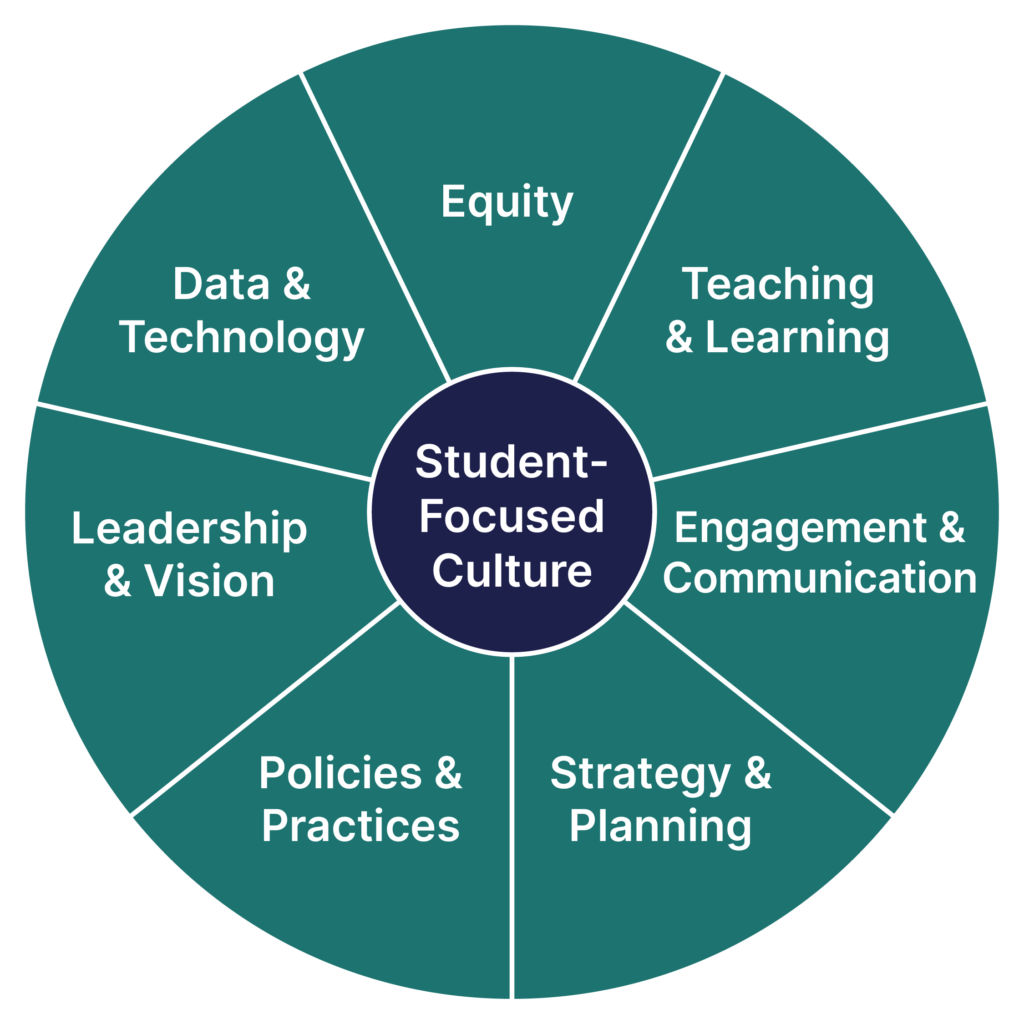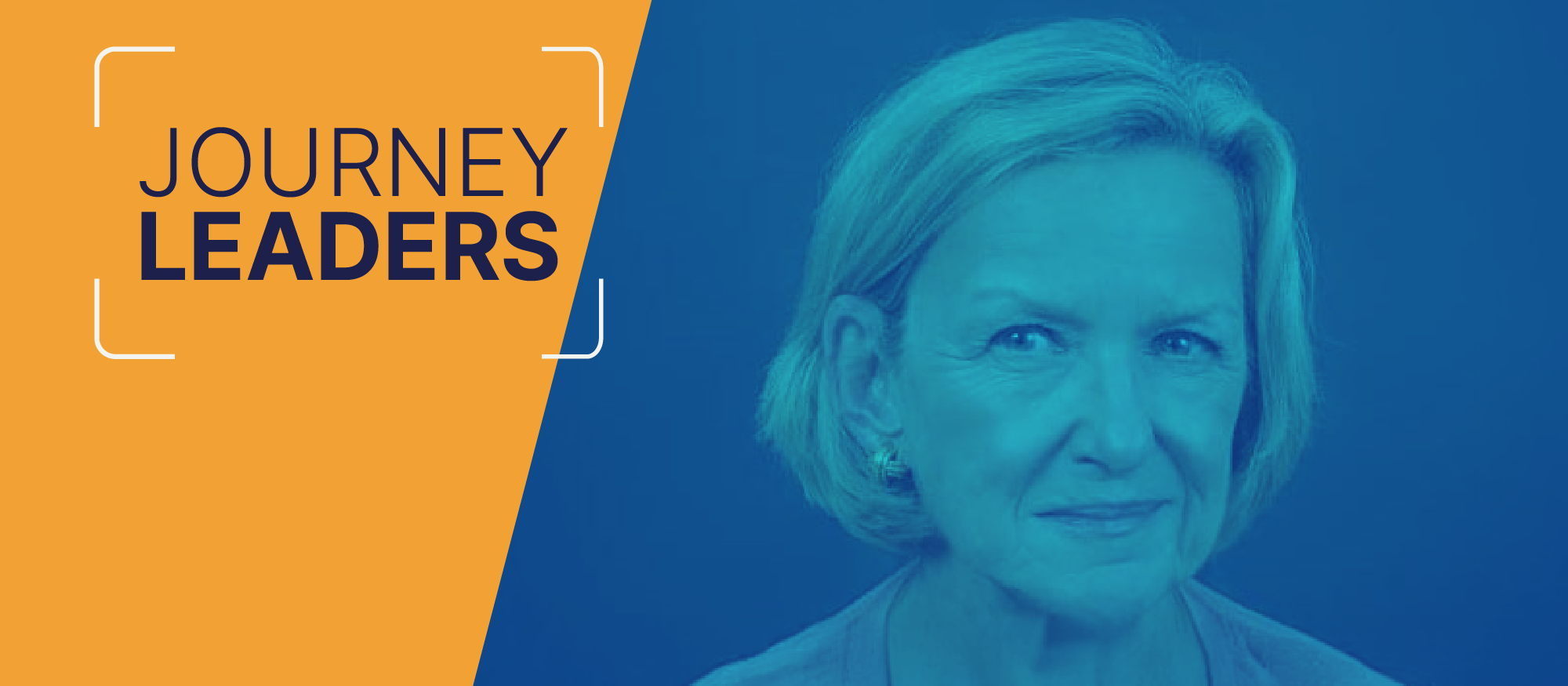At the next DREAM conference in February, Achieving the Dream will celebrate 20 years of progress and transformation in the community college field. For two decades, the organization has grown, changed, and supported colleges that have made lasting impacts across the country.
As leaders, educators, and practitioners across the ATD Network prepare to attend the 20th annual DREAM conference, here’s a look back at ATD over the years, from its initial inception through its biggest transformations — and onward to the next 20 years of equity-centered change.
300+
ATD Network colleges*
2M
students served by Network colleges*
7.7K
coaching hours provided*
* in fiscal year 2022–2023
Founding a movement
In 2003, Lumina Foundation invited select organizations to form a founding partnership focused on community colleges — a five-year demonstration project called Achieving the Dream: Community Colleges Count.
Carol Lincoln, who retired as ATD’s senior vice president in 2023, has been a key leader of ATD since this inception point. At the time she was working for MDC, a nonprofit focused on advancing equity and economic mobility in the rural South.
“My career has been based in what community colleges can do to be catalysts for change,” Lincoln said. When MDC was selected as managing partner of the ATD initiative, the pieces of her career to that point all started coming together.
ATD founding partners
Lumina Foundation
MDC Inc.
American Association of Community Colleges (AACC)
Community College Leadership Program, University of Texas at Austin
Community College Research Center
Institute of Higher Education at the University of Florida
Jobs for the Future (JFF)
MDRC
Public Agenda
Once the team of partners was assembled, ATD took on an initial cohort of 26 colleges from five states. At a time when diversity in higher education was growing rapidly, the ATD pilot focused on areas where reform was most urgent. It was critical for community colleges to demonstrate that they could support their changing populations and produce educated workers for the growing knowledge economy.
ATD’s approach to addressing this challenge took time and expertise to develop.
“When we all started back in 2004, there wasn’t much data to speak of,” Lincoln said. Participating colleges primarily looked at enrollment data, but ATD pivoted to focus on increasing graduation rates. When the Community College Research Center (CCRC) examined data submitted by participating colleges, they found that persistence and completion rates were significantly lower for students in developmental education.
The Developmental Education Initiative, supported by the Bill & Melinda Gates Foundation, became the first major ATD learning initiative. Lincoln also credits Complete College America with helping to push the nationwide understanding that, with tutoring and supplemental instruction, students could immediately enroll in college-level courses and be spared the tedium of remedial classes, a major driving factor in students dropping out.
“It was a big move to show the country that this work wasn’t about fixing students; it was about fixing our institutions,” Lincoln reflected.
Our Network by the numbers
ATD supports more than one in four community colleges in the U.S. through Foundations of Transformation, our core three-year experience.
This means that ATD supports:
100%
of Alaska Native and Hawaiian-Serving Institutions
94%
of Tribal Colleges and Universities
25%
of Historically Black Colleges
25%
of Hispanic-Serving Institutions
Driving whole-college solutions
Achieving the Dream: Community Colleges Count was a unique project focused on the potential for open-access institutions to build equity and opportunity in the communities they served. And as the five-year pilot came to an end, the partner organizations knew it was worth continuing.
Organizational leaders spent a year taking steps to establish Achieving the Dream, Inc., which officially launched in 2010 with Lincoln as senior vice president and Dr. William E. Trueheart as president and CEO.
As ATD expanded operations, including the addition of more than 100 new colleges into the ATD Network over the next five years, the organization also initiated a strategic shift toward the whole-college approach that characterizes its work to this day.
With discrete interventions such as the Developmental Education Initiative, colleges improved outcomes for a small number of students but weren’t seeing systemic change.
By examining the holistic student experience instead and asking how colleges need to change so that they can serve all students, ATD began setting a standard for institutional transformation. This required working with faculty and student service professionals as well as leader and administrators. “Everybody had to be part of the solution,” Lincoln said.
Collective learning by the numbers
ATD’s conferences and learning events bring passionate community college leaders together to exchange ideas and pursue shared goals. In 2023 alone, ATD connected with more than 3,500 leaders, faculty, and practitioners from across the country.
Learn about our upcoming events16
events, conferences, and seminars in 2023
3.5K
event attendees in 2023
500+
colleges attended ATD events
200+
organizations connected with the Network at ATD events
Better data, better decisions
By 2014, ATD had identified several key capacities that were essential to driving whole-college transformation. And to understand where improvements were most urgently needed, colleges needed to understand their data.
ATD coach Laurie Heacock, who was then national director of data, technology, and analytics, took a leading role in the development of the Institutional Capacity Framework, a comprehensive approach to identifying institutional strengths and capacities that lead to a student-centered culture.
“We started having conversations about what successful colleges have in common after going through the ATD experience,” Heacock recalled. “We talk a lot about systems change and broad engagement. So what does that look like in practice?”
Heacock and her team worked with ATD’s coaches — veterans in the field with decades of combined expertise in community college leadership — to identify seven capacities that formed the framework. They then tested the framework and accompanying Institutional Capacity Assessment Tool (ICAT) with 10 pilot colleges before rolling it out across the ATD Network.
Heacock says the Institutional Capacity Framework has played an essential role in helping Network institution take a systems approach to whole-college transformation. “It really is an all-hands approach,” she said. “Everybody can create this student-centered culture and sense of belonging. Everybody feels like they can connect to that wheel in some way.”
ATD staff and coaches are invested in continuous improvement: Colleges engaged in Foundations of Transformation today are using “ICAT 1.5,” a version based on years of fine-tuning. And ATD will soon be releasing an updated tool based on more recent data — “ICAT 2.0” will be announced at DREAM 2024. Register here
The Institutional Capacity Framework
ATD’s field-tested framework is built on seven essential capacities for colleges to create the student-focused culture that promotes student success. Evidence shows colleges must be strong in each capacity area to take on any large-scale interventions. Our Institutional Capacity Assessment Tool (ICAT) helps colleges understand where they’ve been, so they can build a path forward grounded in the fundamentals that make transformation possible.
Learn moreAccelerating our impact
In 2015, Dr. Karen A. Stout joined ATD as its new president and CEO. Under her leadership, the organization has not only grown and restructured itself but, Lincoln believes, has also become a thought leader in the field of higher education reform.
Lincoln estimates that at least 150 colleges need to be involved in an organization like ATD in order for it to influence the national conversation. With more than 300 institutions involved and more than 2 million students served by Network colleges in the last year, ATD’s impact is undeniable.
Leaders from ATD Network institutions consistently share their strategies and success stories at major conferences hosted by ATD, the American Association of Community Colleges (AACC), and the Association of Community College Trustees (ACCT). Since 2013, more than half of all finalists for the prestigious Aspen Prize for Community College Excellence have been ATD Network institutions.
ATD’s influence extends outside of open-access institutions and beyond the U.S.: In 2014, the Kresge Foundation created the University Innovation Alliance, a coalition of research universities that, like the colleges in the ATD Network, are committed to increasing student success and equity in higher education. Kresge also funds Siyaphumelela (“We Succeed”), a higher education initiative in South Africa for which ATD serves as an advising partner.
Funders, too, continue to support the national reform agenda. Notably, philanthropist MacKenzie Scott gave $20 million to ATD in 2021, a gift that has propelled further growth and funded a cohort of new Network colleges focused on accelerating equitable outcomes for students of color.
These organizations “are investing in us as well as in lead institutions,” Lincoln said, “because they’ve seen the track record and they continue to believe that community colleges can be a lever for change.”
Institutional excellence by the numbers
Across the country, ATD Network colleges are advancing the field and defining success for open-access institutions.
Learn about awards and recognition26
Leader Colleges of Distinction
35
Leader Colleges
21
Leah Meyer Austin Award (LMA) winners to date
40%
of Aspen Prize winners are LMA recipients
As committed as ever
Carol Lincoln’s uniquely long-lasting tenure at ATD gives her a unique perspective on how the organization has changed — and what it has changed — in the last 20 years.
One of its biggest impacts, she believes, is the culture of evidence and inquiry that it encourages throughout the ATD Network. When it comes to data-informed decision-making, “Nobody else was talking about that. That’s what we were trying to do in 2004, and that’s what we are known for in 2024.”
ATD has also been a champion of equity-centered transformation since its inception. The organization released a revised equity statement in 2022, signaling a stronger and more intentional focus on leading with equity and calling on Network colleges to be drivers of positive change. This statement has served as a roadmap for many institutions that are committed to serving and supporting all students. A new Equity Toolkit further empowers ATD Network college to design and operationalize equity-centered approaches to all aspects of their work.
For two decades, ATD has shown that when colleges truly understand who their students are and what their students need, they are better equipped to help those students succeed.
In that time span, thanks to efforts from organizations and government initiatives across the country, the percentage of U.S. adults with a post–high school credential has increased significantly. In 2009, 38% of working-age adults had a higher credential. By 2021, that figure had risen to 54%. “That is a huge change in America, and Achieving the Dream had a lot to do with it,” said Lincoln.
The progress of the last 20 years is worth celebrating, but the need for equity-centered reform in higher education is as great as ever.
Achieving the Dream remains as committed as it was in 2004 to help colleges support their students and transform their communities. From better data to stronger partnerships, from coaching that helps leaders achieve their vision to professional learning that empowers faculty as change-makers, ATD’s work continues to make an impact.
The persistent dedication to equity and student success is will continue to define ATD for the next 20 years and beyond. As Carol Lincoln said, “We’re not going to walk away.”




